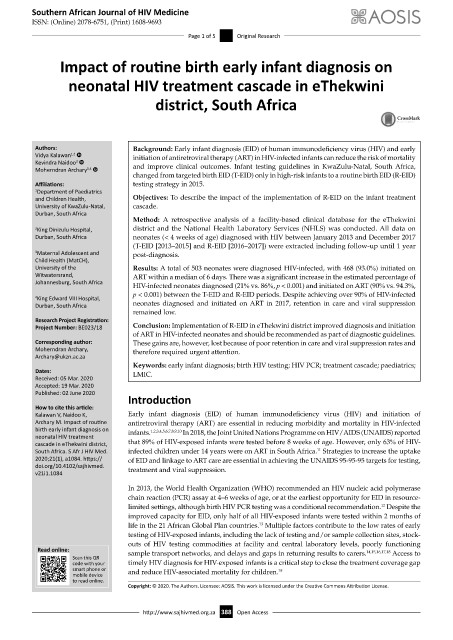Page 396 - HIVMED_v21_i1.indb
P. 396
Southern African Journal of HIV Medicine
ISSN: (Online) 2078-6751, (Print) 1608-9693
Page 1 of 5 Original Research
Impact of routine birth early infant diagnosis on
neonatal HIV treatment cascade in eThekwini
district, South Africa
Authors: Background: Early infant diagnosis (EID) of human immunodeficiency virus (HIV) and early
1,2
Vidya Kalawan initiation of antiretroviral therapy (ART) in HIV-infected infants can reduce the risk of mortality
Kevindra Naidoo 3 and improve clinical outcomes. Infant testing guidelines in KwaZulu-Natal, South Africa,
Moherndran Archary
1,4
changed from targeted birth EID (T-EID) only in high-risk infants to a routine birth EID (R-EID)
Affiliations: testing strategy in 2015.
1 Department of Paediatrics
and Children Health, Objectives: To describe the impact of the implementation of R-EID on the infant treatment
University of KwaZulu-Natal, cascade.
Durban, South Africa
Method: A retrospective analysis of a facility-based clinical database for the eThekwini
2 King Dinizulu Hospital, district and the National Health Laboratory Services (NHLS) was conducted. All data on
Durban, South Africa neonates (< 4 weeks of age) diagnosed with HIV between January 2013 and December 2017
(T-EID [2013–2015] and R-EID [2016–2017]) were extracted including follow-up until 1 year
3 Maternal Adolescent and post-diagnosis.
Child Health (MatCH),
University of the Results: A total of 503 neonates were diagnosed HIV-infected, with 468 (93.0%) initiated on
Witwatersrand, ART within a median of 6 days. There was a significant increase in the estimated percentage of
Johannesburg, South Africa
HIV-infected neonates diagnosed (21% vs. 86%, p < 0.001) and initiated on ART (90% vs. 94.3%,
p < 0.001) between the T-EID and R-EID periods. Despite achieving over 90% of HIV-infected
4 King Edward VIII Hospital,
Durban, South Africa neonates diagnosed and initiated on ART in 2017, retention in care and viral suppression
remained low.
Research Project Registration:
Project Number: BE023/18 Conclusion: Implementation of R-EID in eThekwini district improved diagnosis and initiation
of ART in HIV-infected neonates and should be recommended as part of diagnostic guidelines.
Corresponding author: These gains are, however, lost because of poor retention in care and viral suppression rates and
Moherndran Archary, therefore required urgent attention.
[email protected]
Keywords: early infant diagnosis; birth HIV testing; HIV PCR; treatment cascade; paediatrics;
Dates: LMIC.
Received: 05 Mar. 2020
Accepted: 19 Mar. 2020
Published: 02 June 2020
Introduction
How to cite this article:
Kalawan V, Naidoo K, Early infant diagnosis (EID) of human immunodeficiency virus (HIV) and initiation of
Archary M. Impact of routine antiretroviral therapy (ART) are essential in reducing morbidity and mortality in HIV-infected
birth early infant diagnosis on infants. 1,2,3,4,5,6,7,8,9,10 In 2018, the Joint United Nations Programme on HIV/AIDS (UNAIDS) reported
neonatal HIV treatment
cascade in eThekwini district, that 89% of HIV-exposed infants were tested before 8 weeks of age. However, only 63% of HIV-
11
South Africa. S Afr J HIV Med. infected children under 14 years were on ART in South Africa. Strategies to increase the uptake
2020;21(1), a1084. https:// of EID and linkage to ART care are essential in achieving the UNAIDS 95-95-95 targets for testing,
doi.org/10.4102/sajhivmed. treatment and viral suppression.
v21i1.1084
In 2013, the World Health Organization (WHO) recommended an HIV nucleic acid polymerase
chain reaction (PCR) assay at 4–6 weeks of age, or at the earliest opportunity for EID in resource-
limited settings, although birth HIV PCR testing was a conditional recommendation. Despite the
12
improved capacity for EID, only half of all HIV-exposed infants were tested within 2 months of
life in the 21 African Global Plan countries. Multiple factors contribute to the low rates of early
13
testing of HIV-exposed infants, including the lack of testing and/or sample collection sites, stock-
outs of HIV testing commodities at facility and central laboratory levels, poorly functioning
Read online: sample transport networks, and delays and gaps in returning results to carers. 14,15,16,17,18 Access to
Read online:
Scan this QR
Scan this QR
code with your timely HIV diagnosis for HIV-exposed infants is a critical step to close the treatment coverage gap
code with your
smart phone or and reduce HIV-associated mortality for children. 19
smart phone or
mobile device
mobile device
to read online.
to read online.
Copyright: © 2020. The Authors. Licensee: AOSIS. This work is licensed under the Creative Commons Attribution License.
http://www.sajhivmed.org.za 388 Open Access

